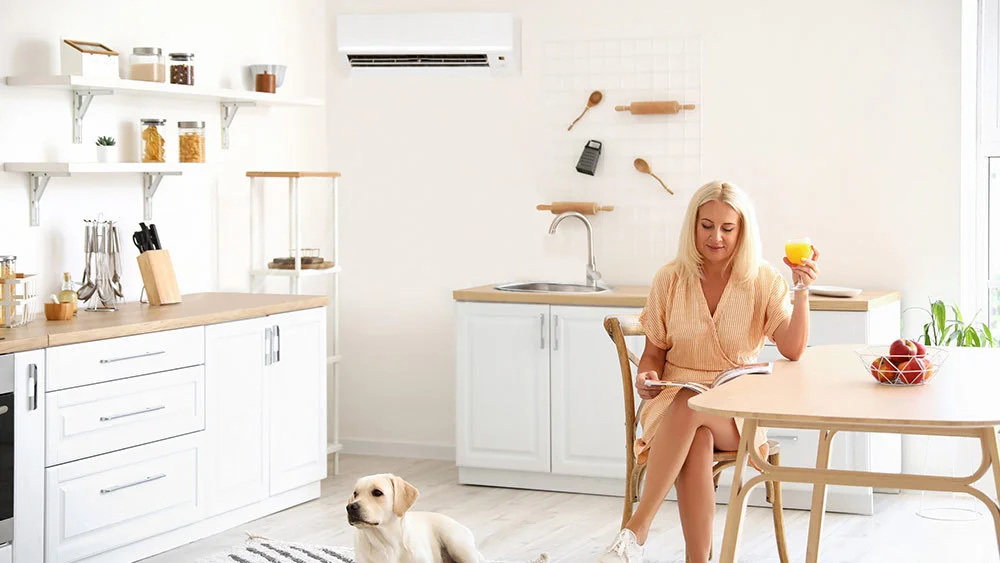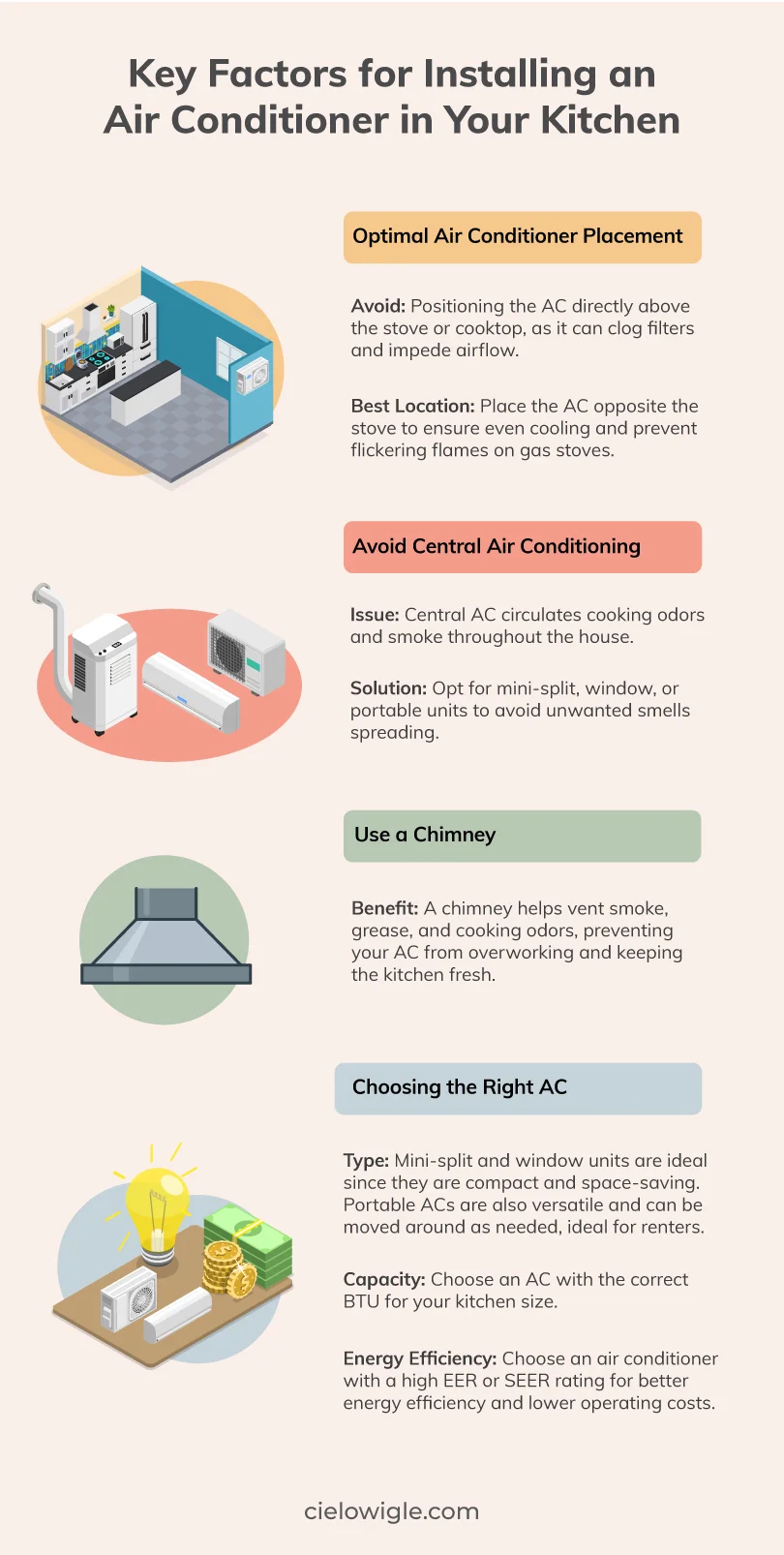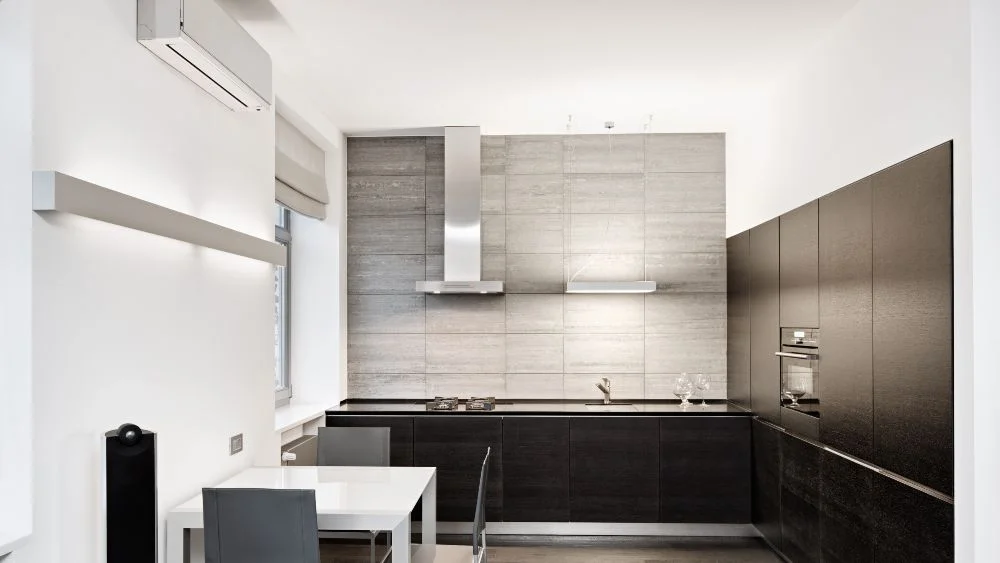
Key Takeaways
- ACs in the kitchen improve comfort and reduce humidity levels.
- Position the AC away from the stove, and ensure proper chimney ventilation for optimal kitchen cooling.
- Opt for a ductless AC (mini-split, window, or portable) based on your kitchen size and avoid central AC.
With the sizzling of spices and the crackle of pans, the kitchen is one of the most vibrant spaces in a house. But it’s also a place where temperatures can escalate rapidly, especially during summer, transforming your joy of cooking into a daunting task. This is where a kitchen air conditioner comes in to help maintain a cool environment.
However, the idea of installing an AC unit in a kitchen can raise some concerns. Can a kitchen air conditioner truly be effective in a space where heat and odors are constant?
This blog explores whether air conditioners can actually be used in the kitchen, factors to keep in mind when installing kitchen ACs, and the best types of units for this space. Furthermore, it offers valuable tips and tricks to optimize the performance of your kitchen air conditioner.
Can ACs Be Used in the Kitchen?
The answer is a resounding yes. While ACs are traditionally associated with cooling living spaces, modern air conditioning systems are equipped to handle the challenges posed by the kitchen environment.
In fact, installing an AC in your kitchen can have numerous benefits:
- Kitchens can get very hot, especially during summer or when using powerful appliances like ovens. The air conditoner can create a more comfortable cooking and dining experience and help maintain freshness.
- ACs remove moisture from the air, which can help prevent mold growth, especially in kitchens where humidity levels can rise due to cooking.
- If your kitchen gets uncomfortably hot, it can impact the overall temperature of your house. A kitchen AC can help maintain consistent comfort throughout your entire living space.
Factors to Consider When Installing Air Conditoner in Your Kitchen
Here are the key factors you need to keep an eye out for when installing a kitchen AC:

-
Optimal Air Conditioning Placement
Avoid positioning the AC directly above your stove or cooktop, as grease and cooking vapors can clog the AC filter over time and impede the airflow. Also, AC air blowing directly onto the gas burner can reduce a gas stove’s ability to heat effectively, resulting in flickering flames and slower cooking.
Position your AC at the end of the kitchen, opposite the stove, to maintain optimal airflow in the area.
-
Avoid Central Air Conditioning
If you have a central AC, each room will likely have supply and return air vents.
When air circulates through vents and ducts, it can carry unwanted smells and smoke from cooking throughout the house. Hence, it is recommended that mini-split, window, or portable units be used instead of central AC in the kitchen.
Related: Mini-Split vs Central Air Conditioner: Which Type Is Best Suitable for Your Home?
-
Use Chimney
Installing a chimney in your kitchen is essential before considering an air conditioner. Without proper ventilation, your kitchen can become excessively hot, causing your AC to overwork. Additionally, a chimney efficiently eliminates smoke, grease, and cooking odors, ensuring a fresh atmosphere and preventing stuffiness.
Choosing The Best Air Conditioner For Your Kitchen
Selecting the right type of air conditioner for your kitchen depends on several factors to ensure it effectively cools the space while managing kitchen-specific challenges. Here are some key considerations when choosing an air conditioner for the kitchen:
-
Type of Air Conditioner
The most suitable AC type for a kitchen is often a mini-split system or a window unit. These units are compact, efficient, and designed for single-room cooling. They’re well-suited for kitchens because they can be installed without taking up valuable counter or floor space. Portable ACs are also highly versatile and can be moved around the kitchen as needed. They don’t require permanent installation, making them suitable for renters.
-
Cooling Capacity
Ensure that the air conditioner’s cooling capacity (measured in BTUs – British Thermal Units) matches the size of your kitchen. A larger space needs a more powerful AC unit to cool the entire area effectively.
Related: What Size Air Conditioner Do I Need?
-
Energy Efficiency
Look for an air conditioner with a high Energy Efficiency Ratio (EER) or Seasonal Energy Efficiency Ratio (SEER). Higher EER/SEER ratings indicate greater energy efficiency, which is important for reducing operating costs.
Maximizing Your AC Performance in the Kitchen: Tips and Tricks

Say goodbye to kitchen discomfort, and let’s explore how to make your kitchen AC work wonders.
-
Block the Heat
Keep blinds or curtains closed on sunny kitchen windows during the day. This prevents direct sunlight from heating the space and making your AC work harder.
Consider using a toaster oven or grill for smaller dishes instead of heating the entire kitchen with your regular oven.
Using induction cooktops offers a distinct advantage because it does not radiate the same heat level into the kitchen as LPG stoves. They heat cookware directly through magnetic induction so the surrounding air remains relatively cool. This reduces the workload on your air conditioner and keeps the kitchen cooler during meal preparation.
-
Make Use of Smart Thermostats
Installing smart thermostats for mini-splits can quickly upgrade your kitchen AC setup. These thermostats offer convenient features such as smart scheduling, allowing you to customize your cooling based on your daily routine.
It will automatically turn your AC on and off at your designated times. For instance, you can have it turned on when you are doing meal preparation or when you are actively using the space. During times when the kitchen is less frequently used, you can schedule the air conditioner to remain off. This not only provides peace of mind but also helps to save energy.
Your best choice to make any mini-split, window,
or portable AC smart. Enhance your comfort and savings.

-
Maintain Your Kitchen AC
Your kitchen air conditioner must be regularly cleaned to be effective. Aim to clean it every two to three months or whenever you see dirt and grime accumulating. Clean the plastic cover with a moist cloth and a moderate detergent.
Furthermore, make sure you clean your air filters in a timely manner. Optimal maintenance involves cleaning them every two weeks, which equates to approximately 200-250 hours of use. Additionally, it’s essential to replace them every 3-4 months. You can utilize a mini-split smart thermostat to get helpful reminders when your filters require cleaning.
Also, check the outdoor unit for debris, such as leaves or branches that may have accumulated around it, obstructing airflow. Keep the area around the condenser clear to allow proper ventilation. Additionally, consider installing a protective cover during the off-season to shield the unit from harsh weather conditions.
Cooking in Comfort
An AC unit effectively combats the heat and humidity that often accompany cooking, turning your kitchen into a cool and inviting space year-round. Whether you’re whipping up a quick weeknight dinner or hosting a gourmet feast, the kitchen air conditioner ensures that you can focus on creating culinary delights without being hindered by uncomfortable temperatures.








